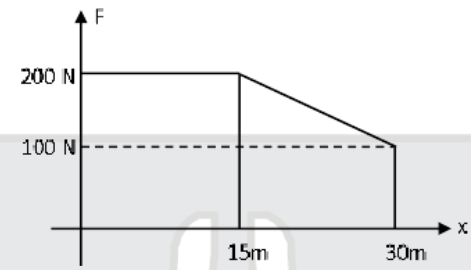If force F=(2x+3x2)N is applied on a particle along x = axis, then find the work done by it during motion of particle from x = 0 to x = 2 m.
To find the work done by the force F=(2x+3x2)N on a particle as it moves from x=0 to x=2m, we can follow these steps:
Step 1: Understand the Work Done Formula
The work done W by a force when it moves an object along a path can be calculated using the formula:
W=∫x2x1Fdx
where F is the force applied, and dx is the infinitesimal displacement.
Step 2: Set Up the Integral
Given the force F=2x+3x2, we need to integrate this force from x=0 to x=2:
W=∫20(2x+3x2)dx
Step 3: Perform the Integration
Now, we will integrate the function:
W=∫20(2x+3x2)dx
This can be split into two separate integrals:
W=∫202xdx+∫203x2dx
Step 4: Calculate Each Integral
1. For the first integral:
∫2xdx=x2
Evaluating from 0 to 2:
(x2)20=22−02=4−0=4
2. For the second integral:
∫3x2dx=x3
Evaluating from 0 to 2:
(x3)20=23−03=8−0=8
Step 5: Combine the Results
Now, we can combine the results of the two integrals:
W=4+8=12J
Final Answer
The work done by the force as the particle moves from x=0 to x=2m is:
12J
The work done W by a force when it moves an object along a path can be calculated using the formula:
W=∫x2x1Fdx
where F is the force applied, and dx is the infinitesimal displacement.
Given the force F=2x+3x2, we need to integrate this force from x=0 to x=2:
W=∫20(2x+3x2)dx
Now, we will integrate the function:
W=∫20(2x+3x2)dx
This can be split into two separate integrals:
W=∫202xdx+∫203x2dx
1. For the first integral:
∫2xdx=x2
Evaluating from 0 to 2:
(x2)20=22−02=4−0=4
∫3x2dx=x3
Evaluating from 0 to 2:
(x3)20=23−03=8−0=8
Now, we can combine the results of the two integrals:
W=4+8=12J
The work done by the force as the particle moves from x=0 to x=2m is:
12J
Similar Questions
A force F = 0.5x + 10 acts on a particle. Here F is in newton and x is in metre. Calculate the work done by the force during the displacement of the particle from x = 0 to x = 2 metre.
View SolutionForce acting on a particle varies with x as shown in figure. Calculate the work done by the force as the particle moves from x = 0 to x = 6.0 m.
View Solution
Knowledge Check
A force F=−kx2(x≠0) acts on a particle in x-direction. Find the work done by this force in displacing the particle from. x=+a to x=2a. Here, k is a positive constant.
A−k2aB−kaC−2kaD−akA force F = (2+ x)N acts on a particle in the x-direction. The work done by this force during a displacement from x = 1.0 m to x = 2.0 m is
A2.1JB2.5JC3.5JD4.5JA force F=Kx2 acts on a particle at an angle of 60° with the x–axis. the work done in displacing the particle from x1 to x2 will be –
Akx22Bk2(x22−x21)Ck6(x32−x31)Dk3(x32−x31)
Force acting on a particle varies with displacement as shown is Fig. Find the work done by this force on the particle from x=−4m to x = + 4m.
 .
.
View SolutionA force of F=(0.5x+12)N acts on a particle. If x is in metre, calculate the work done by the force during the displacement of the particle from x = 0 to x = 4 m
View SolutionA force f=10+2x acts on a particle moving in straight line on x axis the work done by this force during a displacement from x=0 and x=3m
View SolutionA force F=(10+0.5x) acts on a particle in the x-direction. What would be the work done by this force during a displacement from x=0 to x=2m (F is in newton and x in metre)
View SolutionForce on a particle varies with position (x) of particle as shown, calculate work done by force from x=0 to x=30 m.

View Solution
